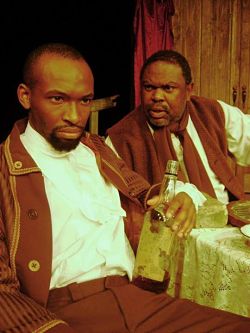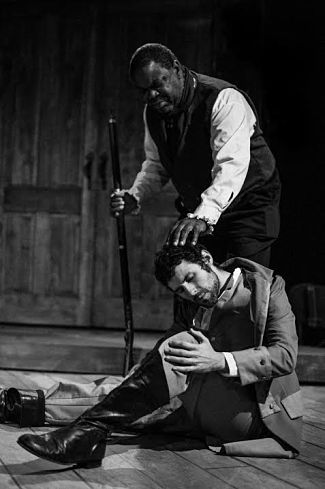Review: The Whipping Man by The City Theatre Company
by David Glen Robinson
Matthew Lopez’s esteemed play The Whipping Man takes on race, America’s central issue from Appomattox until now. The participation of Jewish Americans in slavery and emancipation puts a wry and tragic twist on it all. Director Stacy Glazer and Production Designer Andy Berkovsky deserve commendation from the git-go for their boldness in addressing issues that have been with us for millennia. The competent cast worked very hard to make this beast roar.
Here’s the thing: all the characters in the ruined mansion in Richmond, black and white, are Jewish. The blacks are recently emancipated and the white character is their former young owner. The time is immediately after the surrender at Appomattox.

The characters in the home identify themselves as family and co-religionists, but things have got to change. Simon (Robert Pellette) formerly ran the household. His faith is unshakeable; he is a being of love, and with the new miracle of Emancipation he knows he can remake a world of justice. He is illiterate but has immense practical knowledge, and in Homeric fashion Simon has memorized the Haggadah from listening to others, all for recitation at the Seder.
John (Richard R. Romeo) grew up in the household, learned to read illegally from his white master, and loves books. He makes his living from theft and hustling. He is Stepnfetchit-becoming-Sportin’-Life and has a lethal fondness for the bottle.
Caleb (Andrew Bosworth), scion of the family, returned grievously wounded from war service with the Confederate Army . He largely lost his faith during the war, and throughout the play remains unwiling to accept the implications of Emancipation and the need for change in their familial relations. He wants no change in their power relationships that had him as top dog, even though now he is powerless and incapacitated.
 With nothing but powder kegs on stage, it is surprising that Act I is excessively slow in developing. The act was too long by at least fifteen minutes. A note to the cast: dramatic pauses can lengthen into dramatic lapses. Dropping the energy in a play of exceptionally challenging material can cause the audience to drift away mentally and emotionally. Act I did explain the play’s title. The 'Whipping Man' was someone who provided the service to slaveowners of punishing slaves in need of discipline, usually by use of a bullwhip.
With nothing but powder kegs on stage, it is surprising that Act I is excessively slow in developing. The act was too long by at least fifteen minutes. A note to the cast: dramatic pauses can lengthen into dramatic lapses. Dropping the energy in a play of exceptionally challenging material can cause the audience to drift away mentally and emotionally. Act I did explain the play’s title. The 'Whipping Man' was someone who provided the service to slaveowners of punishing slaves in need of discipline, usually by use of a bullwhip.
The intriguing acknowledgment of family secrets comes in Act II, and these revelations are the abiding strengths of the play. Playwright Lopez knows that secrets within families are knotted together each to each, and when one comes unbound, all of the others seem to explode outward into the light. Act II is impressive, but we had a long wait to get there.
The City Theatre still has persistent technical problems, visible to many through production after production. Lighting instruments on stage right suffer ghosting, or flickering, after almost every change in lighting sets. This distracting problem is getting worse, and it tells season ticket holders that the electrical lighting system is deteriorating. Likewise, the theatre is becoming notorious for flimsy set panels and wobbly doors. One character on the stairs in The Whipping Man bumped the wall and set up a wobble on the wall panel, the stairs, and the out-of-period steel stair railing. The set is supposed to be a ruined but substantial mansion, not a cardboard homeless camp. The City Theatre has an ambitious vision of modern theatre, and all the past seasons’ productions prove that. Investing in infrastructure upgrades soon can save its upcoming worthy offerings from amateurish appearance and declining production values.
 Tragedies need some humor to help them concentrate the pain. Likewise, tragedies are more intense when there is some leavening or lightness that serves to show what is lost, what could have been, but what is not. The Whipping Man sent us to search for all that on our own without much help from the production. It wasn’t until Act II that we found that uplifting charm, that thing by itself that was worth the price of admission.
Tragedies need some humor to help them concentrate the pain. Likewise, tragedies are more intense when there is some leavening or lightness that serves to show what is lost, what could have been, but what is not. The Whipping Man sent us to search for all that on our own without much help from the production. It wasn’t until Act II that we found that uplifting charm, that thing by itself that was worth the price of admission.
This came in the form of Robert Pellette’s repeated singing of Go Down Moses during the Passover Seder. His character Simon offered music, a capella, in Pellette’s rich voice, occasional joined by John. They expressedg all the hope and joy in the miracle felt by all freed slaves. This familiar song bridged the 19th century and the 21st century, establishing the play’s relevance. It brought in thoughts of modern murder and genocide across the world, including in Rwanda, Syria, and North Korea. And then the play hurled us into the despair of Simon’s revelation of what the Whipping Man’s legacy had wrought in him.
That explained it all. At the end, one character enters exile from exile, a personal Exodus with no Promised Land out ahead. The other two sit in their own personal darknesses, awaiting dissolution.
Oddly, for an almost unrelieved tragedy, this was a very satisfying ending.
The Whipping Man
by Matthew Lopez
City Theatre Company
The Whipping Man runs February 7 – March 2.
